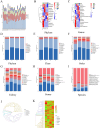Bacillus paralicheniformis LN33 fermented feed improves growth performance in Cherry Valley ducks by enhancing immune function and intestinal barrier integrity
- PMID: 40771965
- PMCID: PMC12327398
- DOI: 10.3389/fvets.2025.1619287
Bacillus paralicheniformis LN33 fermented feed improves growth performance in Cherry Valley ducks by enhancing immune function and intestinal barrier integrity
Abstract
Introduction: This study investigated the effects of feed fermented with Bacillus paralicheniformis LN33 on growth performance, antioxidant capacity, immune response, intestinal barrier function, and gut microbiota in Cherry Valley ducks.
Methods: A total of 480 healthy 7-day-old Cherry Valley ducks (197.33 ± 5.90 g) were randomly divided into four groups. One group received a basal diet (control), while the other three received the basal diet supplemented with 1%, 3%, or 5% fermented feed for 28 days.
Results: Ducks fed 3% fermented feed showed significantly higher final body weight (3,020.00 ± 52.20 g) and average daily gain (100.79 ± 1.73 g) than the control group (2,896.00 ± 120.93 g and 96.39 ± 4.23 g, respectively; P < 0.05). The feed-to-gain ratio decreased significantly (1.79 ± 0.03 vs. 1.87 ± 0.08; P < 0.05), with similar feed intake across groups. Antioxidant enzyme activity increased, while pro-inflammatory cytokine levels decreased. Expression of intestinal tight junction proteins and immune markers improved. The relative abundances of Faecalibacterium, Odoribacter, and Butyricicoccus increased significantly and were positively correlated with intestinal and immune function.
Discussion: These results suggest that B. paralicheniformis-fermented feed enhances growth performance and overall health in Cherry Valley ducks by boosting antioxidant defenses, modulating immune responses, and reshaping the gut microbiota.
Keywords: Bacillus paralicheniformis LN33; Cherry Valley ducks; fermented feed; growth performance; immune function; intestinal barrier.
Copyright © 2025 Jiang, Yang, Lei, Li, Chen and Jiang.
Conflict of interest statement
The authors declare that the research was conducted in the absence of any commercial or financial relationships that could be construed as a potential conflict of interest.
Figures









Similar articles
-
Organic zinc glycine chelate is better than inorganic zinc in improving growth performance of cherry valley ducks by regulating intestinal morphology, barrier function, and the gut microbiome.J Anim Sci. 2023 Jan 3;101:skad279. doi: 10.1093/jas/skad279. J Anim Sci. 2023. PMID: 37606553 Free PMC article.
-
A blend of bacillus-fermented soybean meal, functional amino acids, and nucleotides improves nutrient digestibility, bolsters immune response, reduces diarrhea, and enhances growth performance in weaned piglets.J Anim Sci. 2024 Jan 3;102:skae293. doi: 10.1093/jas/skae293. J Anim Sci. 2024. PMID: 39320170
-
Single or Combined Supplementation of Rhodotorula Yeast Culture and Bacillus Subtilis Enhances Intestinal Barrier Function in Yellow-Feathered Broilers.Vet Sci. 2025 Jun 6;12(6):558. doi: 10.3390/vetsci12060558. Vet Sci. 2025. PMID: 40559794 Free PMC article.
-
Effects of replacing zinc oxide with different levels of zinc lactate on growth performance, serum indexes, intestinal health and gut microbiota in weaned piglets.Front Microbiol. 2025 Jul 11;16:1622700. doi: 10.3389/fmicb.2025.1622700. eCollection 2025. Front Microbiol. 2025. PMID: 40718813 Free PMC article. Review.
-
Effect of Fermented Feed on Growth Performance and Gut Health of Broilers: A Review.Animals (Basel). 2025 Jul 3;15(13):1957. doi: 10.3390/ani15131957. Animals (Basel). 2025. PMID: 40646856 Free PMC article. Review.
References
-
- Xiong J, Wen D, Zhou H, Chen R, Wang H, Wang C, et al. Occurrence of aflatoxin M1 in yogurt and milk in Central-Eastern China and the risk of exposure in milk consumers. Food Control. (2022) 137:108928. 10.1016/j.foodcont.2022.108928 - DOI
-
- Gonzalez Ronquillo M, Angeles Hernandez JC. Antibiotic and synthetic growth promoters in animal diets: review of impact and analytical methods. Food Control. (2017) 72:255–67. 10.1016/j.foodcont.2016.03.001 - DOI
LinkOut - more resources
Full Text Sources

